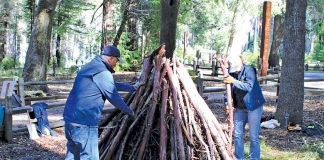With the City of Scotts Valley anticipating several new housing and commercial projects in the coming years, a question among many is, can the water supply support the future of the town.
In short—yes. At least according to the Piret Harmon, General Manager of Scotts Valley Water District.
“There seems to be a notion that we do not do any planning,” Harmon said. “We, as a water district, have planned for growth and we keep our eyes on it all the time, working with the city, etc.”
According to Harmon, it is not planned city growth that may deplete water resources, rather it is the uncertainty of climate change and rainfall. “That is the unknown,” said Harmon.
By 2040, Scotts Valley’s population is projected to be double of what it was in 1985, yet the total amount of the water used is estimated to stay the same. According to the SVWD reports, with the growth the city is planning the water district will go up from 1,200 acre feet needed to 1,400 acre feet needed in approximately the next 20 years. (Acre feet is a unit of measurement which is equivalent to about one football sized field worth of water.)
“People who think we have depleted the aquifer—we have not,” said Harmon. “The amount of water we have to use largely depends on rainfall. In some years it will be way more than we need, in other years we will have to ask people to cut back.”
The last time the usage of water surpassed the amount available was in 1994-2000, due in part to the demand of industrial pumping, which has drastically declined since. Today, water is used much more efficiently. One reason for this, is people are using less water, due to smart environmentally proactive practices and appliances such as toilets and showers are now designed to use less water than 20-30 years ago.
Also, at a state level, earlier this year, Governor Jerry Brown signed a pair of bills that created a framework for statewide water efficiency standards, regardless if the state is in a drought. The laws set an initial limit for indoor water use of 55 gallons per-person per-day in 2022, which gradually drops to 50 gallons per person by 2030.
The average single family home uses 80,000-100,000 million gallons per year, a unit in the multi residential complex uses 50,000 gallons per year.
“The residential demand is very predictable,” Harmon said. According to Harmon, growth can be a good thing for a district. Every new home or customer that connects to the district, creates new revenue to be used for things such as infrastructure repair.
As a district, a study is published every five years projecting the water demand in the next 25 years. The last study was completed in 2015, showing the projected demand does not exceed water production.
In an effort to combat the looming uncertainty of climate change and possible drought, such as the instances seen in Cape Town, Harmon said SVWD is preparing plans to create a groundwater recharge with recycled water that would be drought proof.
“It is something that would be a great asset to us but it is very expensive, approximately $15 million,” Harmon said.
According to Harmon, with additional customers this would help generate revenue for proactive projects and help replace infrastructure that has reached its useful life.
“Water is a shared resource. Growth is not a reason to be concerned at least not when it comes to water supply,” Harmon said. “We are trying to be accessible and transparent to our customers for any questions they might have about water use and water availability.”
In addition to attending SVWD board meetings, calling or visiting the water district’s office, customers can also find SVWD staff at the Scotts Valley Farmer’s Market on the fourth Saturday of every month.











